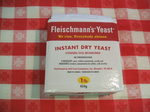Lecithin A Natural Bread Preservative
Not all preservatives are artificial. Lecithin is a natural preservative that comes from soy or egg yolks. Adding lecithin to your regular loaf of bread helps keep it fluffy and light. At the same time, it acts as a natural preservative for your bread. Powdered ascorbic acid is another well-known natural food preservative used in bread. It reduces the growth of microorganisms plus helps the yeast rise faster. You can crush a Vitamin C tablet with a mortar and pestle if you don't have powdered ascorbic acid. Honey, ginger and cinnamon, are all flavorful natural food preservatives and good additions to your breads.
Bread Preservative Recipe
This recipe comes from a friend that uses it in all her breads to keep them fresh longer
1 c. dried lecithin (available thru the Co-Op)
1 T. ginger dried
1 T. citric acid
Mix together and keep in the refrigerator
Add 1 tsp. per loaf of bread to keep it from going stale.
10 Health Benefits Of Lecithin
1. It breaks up cholesterol and fats in our body so it's advisable for those who want to lose weight. Consuming more lecithin means increasing the body's metabolism rate.
2. It's beneficial to anyone who wants to enhance their memory skills. Those with Alzheimer's or amnesia are advised to include lecithin in their diet.
3. Lecithin also cleanses the kidneys and liver which is important to those who are suffering from urinary tract infection and those who love to eat salty and spicy foods. It prevents diseases like gallstones and gallbladder infections.
4. Protects against heart diseases and lowers your cholesterol level while preventing toxins from clogging the arteries.
5. Helps our body absorb essential nutrients better and supports the movement of our body fluids inside and outside our cells.
6. Lecithin nourishes our skin and lessens the possibility of dealing with skin problems like pimples, acne, whiteheads, and blackheads.
7. Increases your physical performance, for those into sports and people who are always on the go. Lecithin can boost the body's energy level without making you fat.
8. If you are suffering from arthritis, lecithin is especially helpful in dealing with this painful ailment. Lecithin contains essential fatty acids that keep muscles, bones, and joints strong and healthy.
9. There are also benefits of lecithin for pregnant women. Studies proved that it can contribute a lot to the development of the fetus' brain and nervous system.

 RSS Feed
RSS Feed
